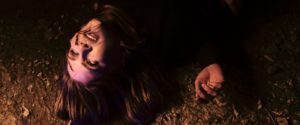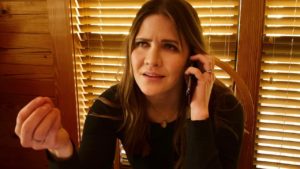One of the most satisfying feelings in the world is when a film seems like it was made specifically for you. Feeling seen and understood by a movie — by a work of art made by a group of creators you’ve never met, who aren’t even aware of your existence — makes you feel less alone in a world that usually feels very lonely. For me, FAYE is that movie. The film, which had its world premiere at the Nashville Film Festival on September 30, is many things. It is a one-woman horror movie shot on a phone. It is a story about grief, trauma, and healing. It is an exploration of mental illness. Most of all, it is a brilliant film that demonstrates that you don’t need a huge budget to connect with your audience; you just need talent and a great idea.
Faye (Sarah Zanotti, who co-wrote the film with director Kd Amond) is a bestselling self-help author on a mandatory writing retreat so that she can produce the new book her publisher is demanding. Faye is still grieving the loss of her husband Jacob, who died in a car accident that left her scarred physically and psychologically. Six months after the accident, Faye is living two lives. Her public persona is confident and reassuring, as she posts live social media updates to let her fans know that she’s hard at work on her next book. Once she turns the camera off, though, she spends most of her time at the remote cabin drinking and talking to her dead husband. She is soon haunted by something other than Jacob’s memory, as a terrifying figure begins tormenting her in the cabin.
Don’t let the synopsis fool you: ‘a woman talks to herself in a cabin’ may not sound like the most thrilling plot in horror history, but FAYE is engaging and suspenseful from beginning to end. Amond and Zanotti wisely use two invaluable tools to make their narrative as compelling as possible: black box segments, where Faye delivers stories to the audience that illuminate and contextualize the events unfolding in the cabin, and Zanotti herself, who is magnetic on screen and carries the film ably. She is alternately hilarious and heartbreaking, tossing off snarky one-liners about the cabin’s rustic decor and asking the empty air where her imaginary husband sits whether they should have children. Faye’s grief and guilt are palpable even when her delusions are not, and anyone who has struggled under the weight of loss and self-recrimination will be able to relate.

Faye also struggles with obsessive-compulsive disorder and post-traumatic stress disorder, and the film’s depiction of the different ways the disorders manifest is frighteningly accurate and accurately frightening. In one wryly hilarious and relatable OCD moment, she admits defeat in the face of an off-center light fixture that she can’t reach, informing the offending fixture that it is “a hateful bitch.” In black box segments, she discusses intrusive thoughts from childhood that were disturbing and violent, concluding, “I think I’m still really scared of myself.” That fear and distrust of herself manifest in her guilt over surviving the car crash that killed Jacob, and she often has panic attacks as she relives the accident. She is trapped inside with all the painful emotions that come with losing someone, and as cliché as it is to say it, the only way out is through. She must face all the ghosts of her past in order to move forward.
Amond and Zanotti achieve a remarkable amount with such limited resources. They take a five-person crew and a minuscule budget and turn FAYE into an indie horror gem. The camera movement is dynamic yet intimate, with the static shots of the black box segments grounding the fluidity of the handheld moments in the cabin. The script is fantastic, doling out clues about Faye’s trauma and her personality through organic phone conversations and the mesmerizing stories that Faye delivers to the audience. Even when she is on a literal stage delivering monologues, nothing about the film feels stagy. Faye’s voice has just the right note of self-awareness, and Zanotti imbues her with such bitterly funny melancholy that you can’t help but root for this broken woman who’s scared to pick up the jagged pieces of her life because she’s bleeding too much already.

In horror, timing is everything, and FAYE’s pacing is pitch-perfect. Amond’s editing is razor sharp, teasing out meaning and character insight from the juxtaposition of Faye’s cabin meltdowns and her introspective black box monologues. The scares all work, lingering just long enough to shock but doing so much more than simply making the viewer jump out of their seat. Zanotti’s physical performance as the apparition — or “Captain Howdy,” as Faye sarcastically calls it, in one of the film’s many horror references — is skin-crawling and eerie, as she contorts her body and perches like a gargoyle with an unsettling grin on her face.
FAYE is frightening, funny, and moving; it is a stellar indie film, a perfect example of the magic that the DIY ‘a few friends and a camera’ school of filmmaking can achieve when the friends involved are as talented as this film’s creators. It is a journey through the five stages of grief that shows just how monstrous our own minds can be. It is an indictment of social media, exposing the gulf between who we are and who we pretend to be. It is a movie that makes me, a grieving woman with OCD and PTSD who has had some of the same conversations Faye has in the film, feel seen and understood and less alone. FAYE is a tremendous film that understands how much horror can say about the world and how much it can say to the lonely, hurting people sitting in front of their screens, hoping to be scared by atmospheric chills and jump scares rather than the tragedies of their own lives.


No Comments